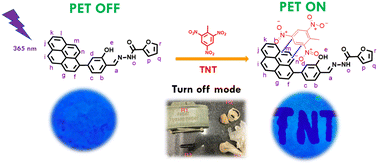A novel pyrenyl-furan hydrazone on paper-based device for the selective detection of trinitrotoluene†
Abstract
A new fluorescent probe (T2) containing pyrene-hydrazone furan moieties was developed and synthesized through a two-step process and then coated onto filter paper to form a paper-based sensor for TNT detection. The T2 sensor uses photoinduced electron transfer (PET) induced fluorescence quenching to detect TNT. The sensor properties were studied using fluorescence spectra, 1H-NMR titration and density functional theory (DFT) calculations. The reaction time of the T2 paper-based sensor for TNT detection was only five minutes. A smartphone was used as an alternative instrument to detect fluorescence signals and a typical image J-processing application was employed to evaluate the grayscale values of the smartphone-captured photographs. The sensor showed a linear concentration range for TNT detection of between 30–500 μM and a detection limit of 30 μM. The T2 paper-based sensor was found to have high selectivity and sensitivity, and it can successfully detect and image TNT in actual samples. This research demonstrates that a T2 paper-based sensor is a promising alternative for TNT detection owing to its short reaction time, high selectivity, sensitivity, and easy applicability.



 Please wait while we load your content...
Please wait while we load your content...